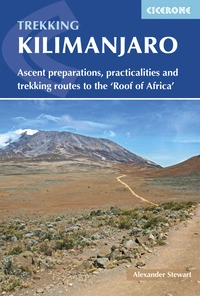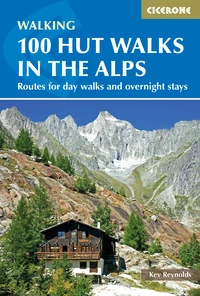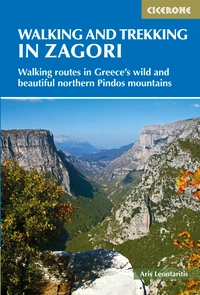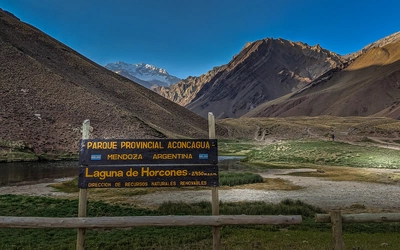Can anyone climb Kilimanjaro, and other frequently asked questions
At 5895m, Kilimanjaro is the world’s highest peak that you can climb without technical skills. But could you climb it? Alex Stewart, author of the Cicerone guidebook to trekking Kilimanjaro, answers some frequently asked questions about trekking to the roof of Africa, one of the coveted Seven Summits. There are two main peaks on the Kilimanjaro massif - Mawenzi and Uhuru. Climbing Mawenzi requires technical skills and a permit which, by all accounts, is nearly impossible to get. Uhuru is the highest, and the acknowledged summit of Kilimanjaro. Usually when people talk about "doing Kilimanjaro" they mean reaching Uhuru Peak.
Kilimanjaro
Ascent preparations, practicalities and trekking routes to the 'Roof of Africa'
£18.95
Guidebook describing all the trekking routes on Kilimanjaro (5895m), one of the Seven Summits. With 6 ascent routes, 3 summit ascents, the Circuit Path and 2 descent paths, the guide also provides comprehensive information on preparation and access, a route on Mt Meru, as well as information on accommodation and other facilities.
More informationHow do you get there?
The gateway towns for Kilimanjaro are Moshi and Arusha, in northern Tanzania. Easiest is a flight to Kilimanjaro International Airport and a transfer to your base at the foot of the mountain. Alternatively, it is possible to pick up a bus transfer from Nairobi in Kenya and cross the border into Tanzania at Namanga.
How difficult is the route?
Essentially, all the routes up Kilimanjaro are walking routes, so you needn’t be a mountaineer or have any particular experience. Not that this should fool you into thinking that it’s easy. You’ll need a good level of basic fitness – you’ll enjoy the hike more if you’re not gasping for breath - but you’ll always have more time in the day to complete the section of path than you’ll need. Trekkers are encouraged to ascend slowly to aid their acclimatisation and give themselves the best chance of success.
When is the best time to go?
Although you can tackle the mountain all year round, the best times to climb Kilimanjaro are from late-December to mid-March and July to October, outside of the rainy seasons. A full moon might brighten the way on summit night; start your trek four days before the full moon date, depending on which route you’re tackling, so the full effect coincides with your attempt on the summit.
Can I hike Kilimanjaro without guides and porters?
No, not anymore. As of 1991 independent trekking was banned, with walkers obliged to sign up with a licensed agency who will provide you with an expedition team consisting of a guide and his assistants, a cook and a crew of porters to carry all of the equipment – you’ll just need to haul yourself and a day pack up the slope every day.
How long will it take?
The quickest ascent and descent run by an operator comes in at five days – in fact you’re not allowed to complete a climb any quicker. The reality is that this short window is too brief to ascend to altitude safely and maximise your chance of success, so most operators run climbs from 6-8 days, with the longest routes, or climbs with additional acclimatisation days built in, coming in at 9-10 days long.
Will you get altitude sickness, and how do you prevent it?
Hikers above 3,500m can be affected by altitude sickness, which might manifest itself in various ways. Mild symptoms include headaches, nausea, loss of appetite, and not being able to sleep. Moderate effects might be a persistent headache, breathlessness and vomiting. If symptoms persist or worsen to the point where you lose coordination or become confused, your guide should intervene and insist that you descend immediately – these are signs of acute mountain sickness, which can be fatal if ignored. Losing elevation ought to see the symptoms ease. Ensure you stay hydrated by drinking at least 3-4 litres daily and eating a lot. Some climbers take Diamox, a drug that aids acclimatisation, but it is not a substitute for a slow and appropriate ascent, and some people suffer adverse reactions to using it – seek advice from a doctor before deciding on whether to use it.
What other health precautions should I take?
You’re safe from malaria on Kilimanjaro as it is too cold and high for mosquitoes. The disease is rife through lower elevations in Tanzania, though, so you should take standard precautions to ensure you are not affected – consult a travel health specialist for advice. Other inoculations you might want to consider include diphtheria, tetanus, typhoid, hepatitis A, polio and yellow fever.
How cold does it get?
In a word, very. The temperature at the summit can plummet to -20C, so make sure that you pack plenty of warm clothing that you can layer against the chill. The lower slopes are far warmer during the day – as high as 29C in January and February – but the nights are still cold, especially if the sky is clear and cloud-free. Do not scrimp on a cheap sleeping bag and either make sure your operator provides a decent one or bring a three-four season bag yourself. Snow showers can occur at any time of year, although they are most likely between April and June, and again between November and December.

How much will it cost?
There’s no escaping the fact that Kilimanjaro is not a cheap climb – Kili is an instance where you get what you pay for and the cheapest, cut-price climbs are also the worst. Plus, by the time that you’ve paid unavoidable park charges, camping, rescue and forest fees, in addition to guide and porter wages, food, transportation and other costs, you’ll find it all adds up. Then there are tips for the hard-working crew at the end, which you shouldn’t overlook. And if you add more days to the length of your climb to aid acclimatisation, this will bump up the cost too but it’s far better to spend this extra amount and boost your chances of success than save a few pounds and miss out on the summit. Realistically, you should budget on spending $2000-3000 on your climb.
So, it’s expensive, cold and life-threatening – is it really worth it?
Absolutely. Climbing Kilimanjaro and standing on the summit, the Roof of Africa, after battling adversity and the challenges involved in getting there, is one of the most incredible feelings you’ll ever experience. Kilimanjaro is an exceptional mountain, a classic climb with varied habitats, scenery, flora and landscapes to experience. The sense of achievement you get from walking through these different zones and making it to the top is almost as big as the mountain itself. Even if you don’t make it to the summit, you’ve still had an amazing walk on the world’s highest free-standing mountain, and that’s something to celebrate.












